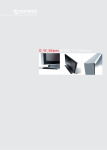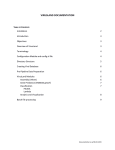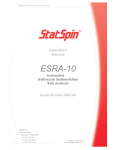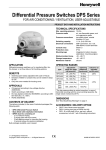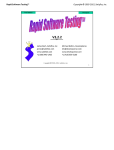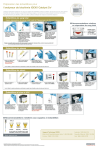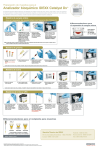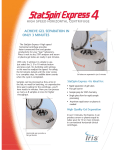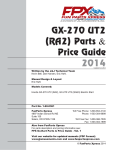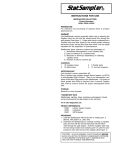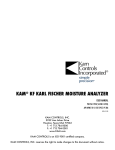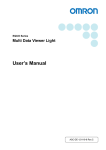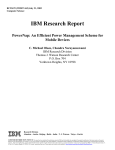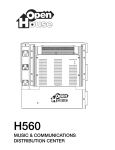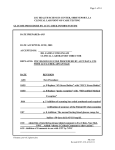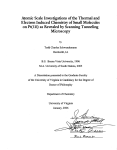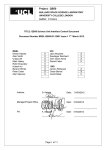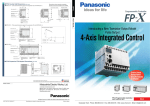Download User`s Manual
Transcript
DiffSpin _____________________________________________ ® Operator's Manual Operator’s Manual for DiffSpin® Slide Spinner Model Number M700-10 M700-12 M700-22 Covered under one or more of the following US patents: StatSpin and accessories: DiffSpin Slide Spinner: #4,846,974 #4,981,585 #5,326,398 Other patents applied for. StatSpin is a registered trademark of StatSpin, Inc. an IRIS Company (International Remote Imaging Systems). Copyright 2002 Printed in U.S.A. TABLE OF CONTENTS 1. 2. 3. 4. INTRODUCTION AND THEORY OF OPERATION 1.1 Introduction 1.2 Clinical Utility 1 1 UNPACKING AND INSTALLATION 2.1 Check for damage sustained during transport 2.2 Check for complete packaging 2.3 Installing the DiffSpin slide spinner 2.4 Power connection 3 3 3 3 WORKING WITH DIFFSPIN 3.1 Controls and indicators 3.2 Safety features and precautions 4 6 INSTRUCTIONS FOR USE 4.1 Collection and preparation of blood sample 4.2 Operation 4.3 Sample Volume 4.4 Analysis of the slide 4.5 Typical results 4.6 Slides 7 8 9 12 12 12 MAINTENANCE 5.1 Cleaning instructions 13 6. SERVICE 14 7. TECHNICAL DATA 14 8. NOTES 8.1 Safety Warning 8.2 General Note 15 15 9. TROUBLESHOOTING GUIDE 16 10. REFERENCES 18 11. WARRANTY FOR THE DIFFSPIN Warranty Card 5. 19 Inside back cover UNIVERSAL PRECAUTIONS Universal Precautions should be followed on all specimens, regardless of whether a specimen is known to contain an infectious agent. Universal Precautions have been stated by Center for Disease Control in 1987 and updated in 1988 and are reprinted in National Committee for Clinical Laboratory Standards proposed guidelines, “Protection of Laboratory Workers From Occupationally Acquired Infections”, Approved Standard, NCCLS Document M29-A2, 2001 (NCCLS, National Office, 940 West Valley Road, Suite 1400, Wayne, PA 190871898, USA). 1. INTRODUCTION AND THEORY OF OPERATION 1.1 Introduction The DiffSpin Slide Spinner is a special purpose instrument for producing uniform monolayer blood smears or films on microscope slides. DiffSpin is compact and easy to use, allowing the user to rapidly prepare reliable blood smears that are technique insensitive. The benefits of DiffSpin are: 1) it’s ability to produce consistent monolayer smears, and 2) the convenience and safety of disposable Slide Holders which collect and contain the excess spun-off blood and minimize aerosols. IMPORTANT: Insure the DiffSpin is on a level surface. 1.2 Clinical Utility The differential white blood cell count has long been recognized as being useful in the diagnosis and prognosis of disease and the monitoring of therapy. There are five potential sources of error or methodological variables in making the differential count. 1. 2. 3. 4. Errors in interpretation or classification of the cells. Statistical sampling errors. Non-random or non-uniform distribution of cells on the slide. Distortion of blood cell morphology by inappropriate anticoagulant, blood storage and handling. 5. Blood film preparation technique. The spinner technique addresses the third and fifth sources of these potential errors. A more complete explanation follows. 1 1.2 Clinical Utility (cont.) The traditional technique to prepare the microscope slide, the manual wedge smear, introduces a source of error as it causes non-random distribution of cells which is dependent on cell size (1). This generally results in an under-reporting of monocytes (7) and a slight overreporting of lymphocytes. This phenomenon is not surprising with the visually apparent non-uniform distribution gradient established using the wedge technique. The slide spinner technique addresses both the non-uniform distribution of cells and preparation technique. By using a slide spinner, all areas covered by cells are good; no searching for a "good" area. Total time to achieve accurate results is less. Indeed, the results achieved with spun slides are more accurate than those prepared using the wedge smear technique (6). Slide spinners were first developed in association with automated differential counters to produce uniform monolayers independent of operator skill (1). Using these early generation slide spinner instruments produced superior quality slides, however, the advantages were offset by the hazards associated with aerosol generation. The DiffSpin was developed to eliminate aerosol formation while providing the higher quality of a spun slide. Using the DiffSpin, when the slide rotates, the excess blood is captured by the slide holder. When used according to the instructions, independent studies indicate there is no detectable aerosol generation (5). In addition, because of the eccentric spinning platform, slides prepared with the DiffSpin are not completely covered with blood. Therefore, prepared specimen slides are readily handled and easily labeled for identification. When the slide rotates, the excess blood is thrown off and captured by the Slide Holder. The remaining blood wets the slide and the thickness of the layer left behind depends on the sample’s viscosity, cell content and surface tension. Though the density of the cellular layer may depend on the sample's viscosity, cell content and surface tension of the glass slide the volume applied the the slide also affects the cell density.(See Section 4.3 Sample Volume) 2 2. UNPACKING AND INSTALLATION 2.1 Check for Damage Sustained During Transport The DiffSpin Slide Spinner and its accessories are delivered in one package. Save the shipping carton in the event the instrument needs to be returned for service. Notify the carrier and your DiffSpin distributor if damage in shipment is evident. 2.2 Check for Complete Packaging • • • • 2.3 Centrifuge Line Cord Operator’s Manual w/Warranty Card DiffSpin Slide Preparation Kit, Product Number DSPK Installing the DiffSpin Slide Spinner Place the DiffSpin on any level surface acceptable for a laboratory instrument. Position the DiffSpin away from direct sunlight and sources of heat and cold. 2.4 Power Connection Before connecting the DiffSpin to the power, please check that the nominal voltage (V~) and frequency (Hz) specified at the rear of the DiffSpin matches your outlet voltage and frequency. If it does not, please contact your supplier. WARNING: If the voltages do not match, do not connect the DiffSpin to the power source! If the voltages match, connect the DiffSpin to a grounded outlet, using the cable provided. This protective grounding must not be neutralized by using an extension cord without a ground lead. Once the DiffSpin is connected to the power it is ready for use. The DiffSpin does not have an ON/OFF switch. 3 3. WORKING WITH DIFFSPIN 3.1 TM Controls and Indicators “stop / open” button • interrupts the cycle and stops the centrifugation. The “stop / open” button is rarely used as the cycles are short. It can be used to release an accidentally latched cover. “power” indicator • green LED, illuminated when the DiffSpin is connected to a power source. The DiffSpin is not provided with an “on/off” switch. The unit is normally left plugged in and “on”. The cover is usually left down but not latched. “start” button • initiates a spin cycle. “ready” indicator • located on the “start” button, the indicator signals that the DiffSpin is ready to process the next specimen (there is a brief delay between cycles). (See Figure 1 on the following page) “acceleration” & “duration” control dials • adjust the acceleration and the duration of the cycle. They are located on the side of the instrument and are usually set at their mid-point (the letter “C”) for all blood samples. Setting “C” should provide adequate films for normal hematocrits. Turn either control toward “E” to increase the spin duration or the acceleration. These adjustments may be necessary for blood samples from patients with disease states that result in major changes in their blood flow characteristics. "Duration" "Acceleration" 0.4 - 3.0 seconds Final rotational speed is inconsequential. Acceleration of the platform (cradle) is responsible for the quality of the blood film. 4 3.1 Controls and Indicators (cont.) NOTE: Some laboratories prefer "acceleration" setting of "D". To adjust the “acceleration” control to a slower setting, first change the control to the desired setting. Then discharge the “memory” of the previous setting. Do this by placing a Slide Holder (with slide) inside the DiffSpin. Close the cover and press the start button. Spin only the slide and Slide Holder with no specimen during this “reset” cycle. The next cycle will now operate at the new speed and setting. Figure 1 DiffSpin, Front View Ready Indicator Stop/Open Start Button Button 5 Control Dials 3.2 Safety features and precautions • The DiffSpin slide spinner incorporates an interlock mechanism. This mechanism prevents the DiffSpin from being operated unless the cover is closed. IMPORTANT: Do not attempt to defeat this safety feature of your DiffSpin instrument. • The DiffSpin prepares blood smears for microscopic examination. Use of the DiffSpin places a responsibility upon administrative personnel to insure adequate training of operators. Do not open the DiffSpin until the slide has stopped rotating. WARNING: Any rotating device can generate a mechanical safety hazard. For the user’s protection, the unit will NOT operate when the cover is open. • Do not leave any blood on the outside of the disposable Slide Holder before spinning. • The DiffSpin is not explosion-proof. Do not use in a potentially explosive atmosphere. • StatSpin slides: 1 x 3 inch, Product No. SL72. • Mount the Slide Holder so that it lies flat on the Cradle. Check that the tabs are securely over the mounting pins. Failure to ensure the Slide Holder is mounted properly may break the slide and/or result in damage to the instrument. (See Figure 2, below) Figure 2 6 4. INSTRUCTIONS FOR USE 4.1 Collection and Preparation of Blood Sample The National Committee for Clinical Laboratory Standards (NCCLS) publication “Reference Leukocyte Differential Count (Proportional) and Evaluation of Instrumental Methods”, Approved Standard, NCCLS Document H20-A, Vol. 12 No. 1 (NCCLS, National Office, 940 West Valley Road, Suite 1400, Wayne, PA 19087-1898, USA) indicates the following for visual differential count: • Use whole venous blood collected in anticoagulanted tubes with tripotassium ethylenediamine tetra-acetate (K3EDTA) 1.5 +/- 0.15 mg (in liquid or powder form) per mL (see NCCLS document H3A4); • Note the specimen condition - Macroscopically visible clots are cause for rejection of the specimen for analysis. Microscopically visible platelet clumps consisting only of platelets are acceptable, provided their presence is noted; • Slides are to be prepared within 4 hours of blood collection in K3EDTA; • Blood samples are to be stored at room temperature until blood smear has been prepared; • Use StatSpin Slides, Product No. SL72. • Make sure that the blood is well mixed. Use a blood tube rocker or similar device if there is any delay in preparing the blood smear. Manual mixing is allowable as long as the blood tube is inverted completely at least 20 times. This will mix the blood and minimize artifacts such as rouleaux formation; • Stain the film within one hour of preparation with either a Romanowsky stain, containing fixatives or fix within one hour with "water-free" (i.e., <3% water) methanol for later staining. 7 4.2 Operation 1. Insert a clean slide Product No. SL72, (frosted edge out) into a disposable Slide Holder, Product No. SC01. 2. Place the Slide Holder (with slide) onto the cradle by placing the holes in the tabs (located on the sides of the Slide Holder) over the silver colored mounting posts and press down gently until the Slide Holder comes to rest flush on top of the cradle. (See Figure 2). IMPORTANT: The labeled end of the slide should rest between the slide retaining posts on the Cradle. 3. With a StatSpin Transfer Pipette (Product No. PD50), place a single drop of blood into each of the two holes located on the top of the Slide Holder (See Section 3.2). The two drops must pool together to ensure uniform coverrage, this takes a second or two. Be careful not to leave any blood on the outside of the disposable Slide Holder before spinning. 4. Spin the slide immediately after adding the blood. 5. Close cover firmly until it latches. Press “ START” button. The cycle is less than 3 seconds. 6. When unit comes to a stop, squeeze the latch on the cover, lift upward to open. (See Figure 3 below) Figure 3 8 4.2 Operation (cont.) 7. Remove the disposable Slide Holder containing the slide. 8. Remove the slide and air dry or oven dry as your lab procedures indicate. When slide is dry it may be stained or processed in the usual manner. 9. Dispose of the contaminated Slide Holder as you would other biohazardous material. IMPORTANT: Use Slide Holders only once.The Slide Holders are designed for single use only. NOTE: There is a built-in time delay between cycles. Wait until the “ready” indicator is lit before initiating the next cycle. (See Figure 1 Section 3.1) A new cycle can not be initiated until the time delay has elapsed. 4.3 Sample Volume For best results, use 50 ul of whole blood placed in each of the holes in the slide holder. The drops should "pool" to create a bar formation. This bar formation will adequately cover the slide and provide good viewing area. The density of the cellular layer depends on the sample's viscosity, cell content and surface tension of the glass slide. The volume applied to the slide also affects the cell density on the blood film. Operator's preference of volume varies greatly. Sample Volume continued next page. 9 4.3 Sample Volume (cont.) • • The following are some suggestions for sample volumes: For lower cell density, some laboratories report best results with total volume of 40 ul (i.e, 0.040 ml) of blood pipetted into each hole of the slide holder. With small quantities of blood, the slide will not be uniformly coated with a film, however, the spacing between the cells will be greater something that may be preferred for faster cell recognition. For higher cell density (and a larger area of the slide to be covered), some laboratories apply 2 x 65 ul (i.e., 2 x 0.065 ml) drops of blood. Although this produces a more fully covered slide, this much surface area is not really necessary. Do not exceed 75 ul per drop as blood will exit the slide holder and cause excessive aerosols. Examination Area shown below is best for viewing red cell morphology. Figure 4 Representation of 2 x 50 ul drops NOTE: The two drops of blood must merge or pool together to ensure uniform coverage. Sample Volume continued next page 10 4.3 Sample Volume (cont.) • The amount of blood added to create a monolayer film with the DiffSpin is a matter of preference. The smaller volumes create a more spread out cell monolayer under the microscope, but may not have the same slide coverage as larger volumes. Also, other cell suspensions may also be used to create a monolayer on a microscope slide. Pipettes For best results use StatSpin pipettes, with a premeasured drop size of 50 ul. Order StatSpin Product Number PD50. 11 4.4 Analysis of the Slide The peripheral blood smear made with your DiffSpin slide spinner should be read according to your laboratory protocol. 4.5 Typical Results About 70% of the slide will be covered with a monolayer of blood cells. The areas covered on typical DiffSpin slides are shown in Figure 4. Nearly all of these covered areas are available for counting. Depending on the aperture of the microscope, there will be over 20,000 high-power fields (100x) available to the user. This area is always larger than the “feathered” area used on the wedge smear. Red blood cell morphology varies with the method of preparation (2). Spun films may display slightly different morphology in some areas of the slide than smears prepared by the wedge method. However, similar as with the wedge method the user will easily identify those areas that enable accurate identification of red cell morphology. Distribution of white blood cells is uniform through out a spun blood smear (1). The uniformity of blood smears prepared by DiffSpin depends on the quality of the microscope slides. 4.6 Slides The uniformity of blood smears prepared with either manual or automated systems depends on the quality of the microscope slides. For best results use StatSpin microscope slides, Product Number SL72. StatSpin slides are clean, dustfree and dehydrated, which is a prerequisite for consistent results. Other various commercially available pre-cleaned slides may result in inadequate blood films if the slide surface is covered with dust or debris particles, or if the slides have been exposed to humid storage conditions. Always use clean desiccated slides and handle them carefully. Avoid touching slide surface. Oil from fingers on the slide surface will result in a non-uniform film. 12 4.6 Slides (cont.) Slides must be fresh. Non-uniform slide coverage (e.g. streaking or "fingering") is a result of poor quality slides that have degraded resulting in increased surface tension (e.g. glass slides stored for months without protection from humidity and temperature). This increased surface tension is found with poor quality slides, slides which were exposed to humidity, or slides stored for excessive lengths of time. If this condition persists try a new box of StatSpin slides (Product Number SL72). 5. MAINTENANCE 5.1 Cleaning Instructions The DiffSpin requires no maintenance beyond routine cleaning. Prior to cleaning, the power cord should be disconnected. Clean the exterior surface and inner surface or bowl area with a 10% bleach solution on a damp cloth. Never have liquid inside the bowl. Do not use abrasives or solvents. Clean the clear cover with a glass/plastic cleaner if required. Any machine or accessory containing accumulated blood and/or other chemical deposits must be cleaned prior to shipment to the manufacturer/distributor for service. This decontamination is required by Federal Law (Title 48 and 49 of the Code of Federal Regulations) and in accordance with the E.P.A's Regulations for Biohazard Waste Management. This decontamination cannot be performed by StatSpin personnel. 13 6. SERVICE The DiffSpin has no user serviceable parts. Should the instrument require service please consult your Warranty for instructions IMPORTANT: The DiffSpin contains components which have a potential SHOCK HAZARD. The unit should only be opened by trained and qualified personnel. 7. TECHNICAL DATA Power Requirements: Product: DS02-10 100 VAC, 50/60 Hz DS02-12 120 VAC, 50/60 Hz DS02-22 240 VAC, 50/60 Hz Running Time: 0.4 to 3.0 seconds Slide Holder: Disposable; accepts 1 x 3 inch microscope slides. Dimensions: 6.5 inches (16.5 cm) diameter by 4.5 inches (11.4 cm) high. Weight: 3.7 pounds (1.7 kg) 14 8. NOTES 8.1 Safety Warning This DiffSpin left the factory in perfect order from the point of view of work safety. To keep it that way and to ensure safe operation, the user must follow the instructions and warnings given in this operating manual. 8.2 General Note The data and information provided in this manual correspond to the state of knowledge existing at the time of printing this manual. Any important changes will be taken into account in the next edition of this manual or with the Package Insert sheet included with the Slide Holders. In every case, the respective package insert should be regarded as definitive. 15 9. TROUBLESHOOTING GUIDE DESCRIPTION POSSIBLE CAUSE OPERATOR RESPONSE Power light not lit Power cord unplugged from DiffSpin or from outlet. Verify that the power cord is plugged securely into the outlet and into the DiffSpin. Non-functioning outlet. Verify that outlet is functioning properly. LED burned-out Verify DiffSpin is still operational. Start button not depressed fully. Retry by pushing start button. Cover not closed properly. Verify that cover is closed tightly. Unit not “ready”. Verify “ready” light is lit before initiating cycle. Unclean slides. Verify that slides are without dust and/or fingerprints. See Section 4.6 "Slides". Inappropriate sample volume. Verify sample volume, refer to Section 4.3. Cradle does not rotate Poor Quality Blood Films 16 DESCRIPTION POSSIBLE CAUSE OPERATOR RESPONSE Poor Quality Blood Films Time and speed settings not correct. Verify position of time and speed knob at recommended “C” mark for average hematocrit levels. Blood escapes Slide Holder Excessive amount of blood. Verify drops only large enough to cover slide. Blood on outside of holder. Verify that no blood is present on exterior of slide holder after pipetting blood onto slide. Slide Holder does not lay flat on Cradle Slide holder not positioned correctly. Check Figure 2, Section 3.2 and verify Slide Holder and slide are oriented properly on cradle. Slide and/or Holder dislodges during spinning Slide holder not positioned correctly. Check Figure 2, Section 3.2 and verify Slide Holder and slide are oriented properly on cradle. Smear area covers frosted edge of slide Slide placed incorrectly into Slide Holder. Verify that frosted edge of slide protrudes from Slide Holder when assembled. 17 10. REFERENCES 1. "Blood Sample Preparation for Automated Differential Systems", Rogers, Charles H., American Journal of Medical Technology, Vol. 39, No. 11:435-442, November 1973. 2. "The Automated Differential; Pattern Recognition Systems, Precision, and the Spun Smear", Kingsley, Thomas C., Blood Cells, 483-487, 1980. 3. "The Use of Wedge and Spun Blood for Reference WBC Differential Counts", Abstract presented at International Society of Laboratory Hematology, 6th International Symposium on Technological Innovations in Laboratory Hematology, Berend Houwen, et al., Santa Fe, New Mexico, March 1993. 4. "Causes for Poor Leukocyte Distribution in Manual Spreader-Slide Blood Films," Steine-Martin, E.A., American Journal of Medical Technology, Vol. 46, No. 9, May 1980. 5. "Automation and Laboratory Hematology: Impact on Quality and Cost Effectiveness", B. Houwen, et al., American Society of Clinical Pathology / College of American Pathologists, Hematology Seminar, Orlando, Florida, October 19, 1993. 6. "Flow Cytometric White Blood Cell Differential: A Proposed Alternative Reference Method", L. Lebeck, et al., Sysmex Journal International, 3, 61-69, 1993. 7. "A Critical Evaluation of the Manual / Visual Differential Leukocyte Counting Method", Koepke, J.A., et al., Blood Cells, 11, 173-186, 1985. 1/15/02 54-002663-001 Rev. B 18 11.0 WARRANTY FOR THE DIFFSPIN CENTRIFUGE StatSpin takes pride in its products and believes that the quality, utility and value we build into each instrument will provide complete customer satisfaction. StatSpin warrants to the original purchaser that this instrument will be free from defects in material or workmanship under normal and proper use for a period of one year from the date of installation. StatSpin will at its option, repair or replace any unit covered under this warranty returned to StatSpin with shipping costs prepaid. Repaired or replaced instruments supplied under this warranty will carry only the remaining portion of the original warranty. For warranty terms and conditions outside the United States, contact your Authorized StatSpin Distributor. StatSpin shall not be responsible for damage to a StatSpin instrument resulting from misuse, negligence, accident, or resulting from unauthorized repairs, alterations, or improper installation. Additionally, StatSpin shall not be liable for any claims, losses or damages of any third party or for lost profits or indirect or consequential damages of any kind even if StatSpin has been advised of the possibility of such damages. The purchaser shall be deemed liable for any and all claims, losses or damages incurred by the use or misuse of the StatSpin instrument by the purchaser, its employees or others, following receipt of the instrument. THIS WARRANTY IS GIVEN EXPRESSLY AND IN LIEU OF ALL OTHER WARRANTIES, EXPRESSED OR IMPLIED. THE PURCHASER AGREES THAT THERE IS NO WARRANTY OF MERCHANTABILITY OR OF FITNESS FOR ANY INTENDED PUPOSE AND THAT THERE ARE NO OTHER REMEDIES OR WARRANTIES, EXPRESSED OR IMPLIED, WHICH EXTEND BEYOND THE DESCRIPTION ON THE FACE OF THIS AGREEMENT . NO AGENT OR EMPLOYEE OF STATSPIN IS AUTHORIZED TO EXTEND ANY OTHER WARRANTY OR TO ASSUME FOR STATSPIN ANY LIABILITY EXCEPT AS SET FORTH ABOVE. 19 85 Morse Street Norwood, Massachusetts 02062 USA http://www.statspin.com telephone 800-782-8774 781-551-0100 fax 781-551-0036
























